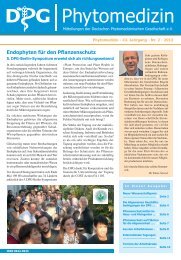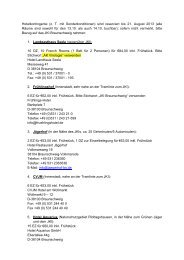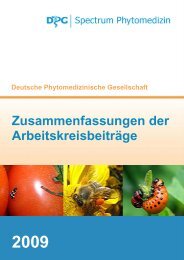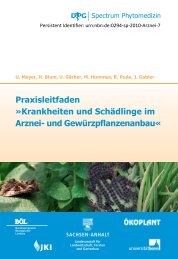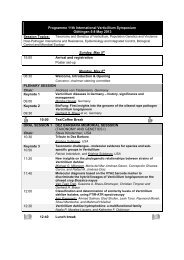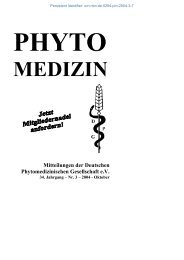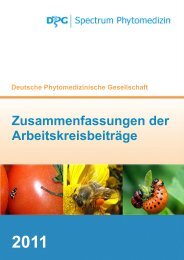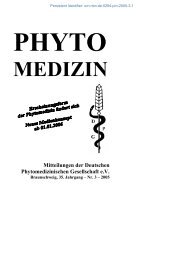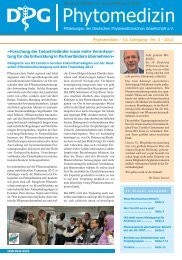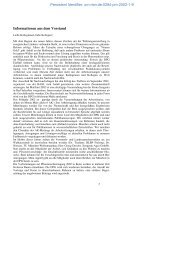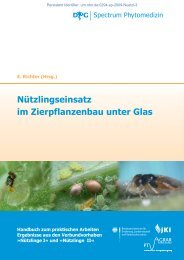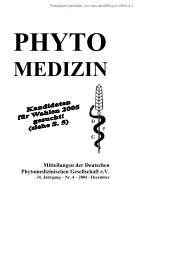fourth joint meeting of dutch and german
fourth joint meeting of dutch and german
fourth joint meeting of dutch and german
Create successful ePaper yourself
Turn your PDF publications into a flip-book with our unique Google optimized e-Paper software.
ABSTRACTS<br />
Oral Presentations<br />
Coat protein enhances translational efficiency <strong>of</strong> Alfalfa mosaic virus RNAs <strong>and</strong> interacts<br />
with eIF4F<br />
JF Bol 1 , IM Krab 1 <strong>and</strong> DR Gallie 2 .<br />
1 Institute <strong>of</strong> Biology, Gorlaeus Laboratories, Leiden University <strong>and</strong> 2 Department <strong>of</strong> Biochemistry,<br />
University <strong>of</strong> California, Riverside, California 92521<br />
E-mail: j.bol@chem.leidenuniv.nl.<br />
Translation <strong>of</strong> eukaryotic mRNAs is strongly enhanced by the formation <strong>of</strong> a closed loop structure<br />
due to the interaction between the poly(A)-binding protein bound to the 3'-poly(A) tail <strong>and</strong> the<br />
eIF4G subunit <strong>of</strong> the eIF4F complex bound to the 5' cap structure. The three plus-str<strong>and</strong> genomic<br />
RNAs <strong>of</strong> Alfalfa mosaic virus (AMV) <strong>and</strong> the subgenomic messenger for viral coat protein (CP)<br />
contain a 5'-cap structure but no 3'-poly(A) tail. Binding <strong>of</strong> CP to the 3'-end <strong>of</strong> AMV RNAs is<br />
required for efficient translation <strong>of</strong> the viral RNAs <strong>and</strong> to initiate infection in plant cells. To study the<br />
role <strong>of</strong> CP in translation, plant protoplasts were transfected with luciferase (Luc) transcripts with 3'terminal<br />
sequences consisting <strong>of</strong> the 3'-untranslated region <strong>of</strong> AMV RNA 3 (Luc-AMV), a poly(A)<br />
tail <strong>of</strong> 50 residues (Luc-poly(A)), or a short vector-derived sequence (Luc-control). Pre-incubation <strong>of</strong><br />
the transcripts with CP had no effect on Luc-expression from Luc-poly(A) or Luc-control but<br />
strongly stimulated Luc-expression from Luc-AMV. From time-course experiments it was calculated<br />
that CP-binding increased the half-life <strong>of</strong> Luc-AMV by 20% <strong>and</strong> enhanced its translational efficiency<br />
about 40-fold. The stimulation <strong>of</strong> translation by CP was cap-dependent <strong>and</strong> could be reproduced in<br />
yeast cells. GST-pull-down assays revealed the binding <strong>of</strong> AMV CP to initiation factor complexes<br />
eIF4F <strong>and</strong> eIFiso4F from wheat germ. By Far-Western blotting it was shown that this binding<br />
occurred through an interaction <strong>of</strong> CP with the eIF4G <strong>and</strong> eIFiso4G subunits <strong>of</strong> eIF4F <strong>and</strong><br />
eIFiso4F, respectively. The results support the hypothesis that the role <strong>of</strong> CP in translation <strong>of</strong> viral<br />
RNAs mimics the role <strong>of</strong> the poly(A) binding protein in translation <strong>of</strong> cellular mRNAs.<br />
Recombination-replication-repair interface <strong>of</strong> geminiviruses<br />
H Jeske, B Alberter, E Bejarano, J Castillo, G Morilla, AM Rezaian, W Preiß <strong>and</strong> C Wege<br />
Institute <strong>of</strong> Biology, Department <strong>of</strong> Plant Molecular Biology <strong>and</strong> Virology, University <strong>of</strong> Stuttgart<br />
E-mail: holger.jeske@bio.uni-stuttgart.de<br />
One major driving force <strong>of</strong> geminivirus evolution is recombination. They may exchange genomic<br />
components (pseudorecombination) as a prerequisite for true molecular recombination <strong>and</strong> may<br />
acquire thus new DNA components like DNAs B, beta DNAs, satellite DNAs or even DNAs <strong>of</strong><br />
different viruses as it has been shown for nanovirus DNA circles. Using an optimized twodimensional<br />
gel electrophoresis in combination with hybridization <strong>and</strong> electron microscopy we have<br />
discovered that the recombinational flexibility is reasoned by a recombination-dependent replication<br />
mode (RDR) that is widespread at least among begomoviruses <strong>and</strong> curtoviruses but does also<br />
occur for satellites, beta DNAs <strong>and</strong> artificial episomes. Compared to complementary str<strong>and</strong><br />
synthesis (CSR) <strong>and</strong> rolling circle replication (RCR), which both were found together with RDR, the<br />
latter mechanism allows the virus to repair every broken or unfinished DNA intermediate as far as<br />
homologous templates are available. Using virus-specific two colour detection, we found out the<br />
the frequency by which different geminiviruses enter the same nucleus was surprisingly high in<br />
tomatoes <strong>and</strong> N. benthamiana, so that the chance to recombine two viruses is extremely high.<br />
Moreover, weeds are ideal cradles for new geminiviruses since they are reservoirs <strong>and</strong> collect<br />
several virus species over years, as exemplified for Sida micrantha-associated geminiviruses.<br />
Surveying different combinations <strong>of</strong> geminiviral <strong>and</strong> satellite DNAs two strategies can be<br />
discriminated between Old World <strong>and</strong> New World begomoviruses. The first were rather promicous<br />
to transreplicate other DNAs, even without a cognate Rep-binding sequence, whereas the latter<br />
need the interaction <strong>of</strong> Rep <strong>and</strong> Rep-binding sequences <strong>and</strong> consequently DNAs B were acquired<br />
by shuffling <strong>of</strong> the regulatory region (common region CR) by homologous recombination. The<br />
consequences <strong>of</strong> these findings for efficient resistance breeding <strong>and</strong> epidemiology will be<br />
discussed.<br />
6



